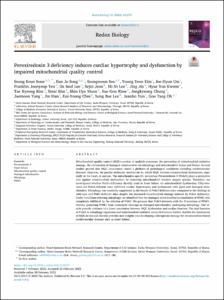Peroxiredoxin 3 deficiency induces cardiac hypertrophy and dysfunction by impaired mitochondrial quality control
- Title
- Peroxiredoxin 3 deficiency induces cardiac hypertrophy and dysfunction by impaired mitochondrial quality control
- Author(s)
- Sonn, Seong Keun ; Song, Eun Ju ; Seo, Seungwoon ; Kim, Young Yeon ; Um, Jee-Hyun ; Yeo, Franklin Joonyeop ; Lee, Da Seul ; Jeon, Sejin ; Lee, Mi-Ni ; Jin, Jing ; Kweon, Hyae Yon ; Kim, Tae Kyeong ; Kim, Sinai ; Moon, Shin Hye ; Rhee, Sue Goo ; Chung, Jongkyeong ; Yang, Jaemoon ; Han, Jin ; Choi, Eui-Young ; Lee, Sung Bae ; Yun, Jeanho ; Oh, Goo Taeg
- Issued Date
- 2022-05
- Citation
- Redox Biology, v.51
- Type
- Article
- Author Keywords
- Peroxiredoxin 3 ; Heart failure ; Mitochondrial quality control ; Damaged mitochondria ; Mitophagy ; PINK1
- Keywords
- PEROXIDASE ; MITOPHAGY ; DYNAMICS ; PINK1 ; ROS ; HEART-FAILURE ; OXIDATIVE STRESS
- ISSN
- 2213-2317
- Abstract
- Mitochondrial quality control (MQC) consists of multiple processes: the prevention of mitochondrial oxidative damage, the elimination of damaged mitochondria via mitophagy and mitochondrial fusion and fission. Several studies proved that MQC impairment causes a plethora of pathological conditions including cardiovascular diseases. However, the precise molecular mechanism by which MQC reverses mitochondrial dysfunction, especially in the heart, is unclear. The mitochondria-specific peroxidase Peroxiredoxin 3 (Prdx3) plays a protective role against mitochondrial dysfunction by removing mitochondrial reactive oxygen species. Therefore, we investigated whether Prdx3-deficiency directly leads to heart failure via mitochondrial dysfunction. Fifty-two-week-old Prdx3-deficient mice exhibited cardiac hypertrophy and dysfunction with giant and damaged mitochondria. Mitophagy was markedly suppressed in the hearts of Prdx3-deficient mice compared to the findings in wild-type and Pink1-deficient mice despite the increased mitochondrial damage induced by Prdx3 deficiency. Under conditions inducing mitophagy, we identified that the damaged mitochondrial accumulation of PINK1 was completely inhibited by the ablation of Prdx3. We propose that Prdx3 interacts with the N-terminus of PINK1, thereby protecting PINK1 from proteolytic cleavage in damaged mitochondria undergoing mitophagy. Our results provide evidence of a direct association between MQC dysfunction and cardiac function. The dual function of Prdx3 in mitophagy regulation and mitochondrial oxidative stress elimination further clarifies the mechanism of MQC in vivo and thereby provides new insights into developing a therapeutic strategy for mitochondria-related cardiovascular diseases such as heart failure. © 2022
- Publisher
- Elsevier BV
- Related Researcher
-
-
Lee, Sung Bae
- Research Interests Cellular mechanism of neurodegenerative diseases; Neuronal maintenance and remodeling; 퇴행성 뇌질환의 세포기전; 신경계 유지 및 리모델링 연구
-
- Files in This Item:
-
 기타 데이터 / 16.7 MB / Adobe PDF
download
기타 데이터 / 16.7 MB / Adobe PDF
download
- Appears in Collections:
- Department of Brain Sciences Laboratory of Neurodegenerative Diseases and Aging 1. Journal Articles



